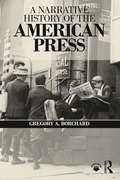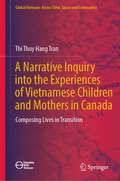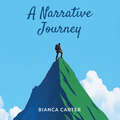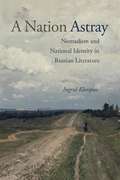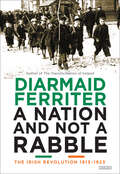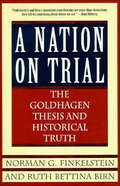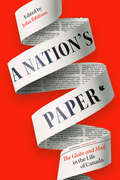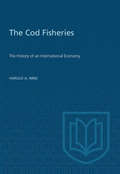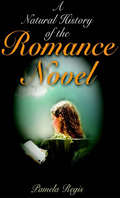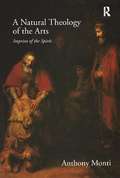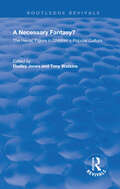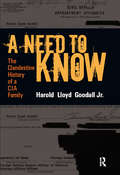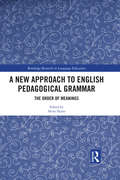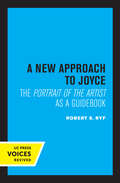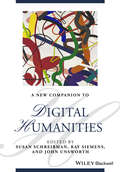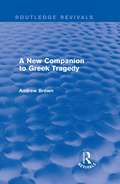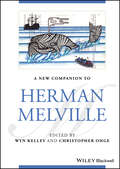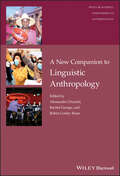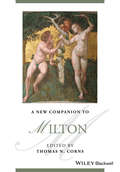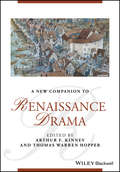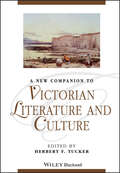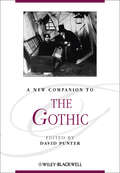- Table View
- List View
A Narrative History of the American Press
by Gregory A. BorchardBeginning with the American Revolution and spanning over two hundred years of American journalism, A Narrative History of the American Press provides an overview of the events, institutions, and people who have shaped the press, from the creation of the First Amendment to today. Gregory A. Borchard’s introductory text helps readers develop an understanding of the role of the press in both the U.S. and world history, and how American culture has shaped—and been shaped by—the role of journalism in everyday life. The text, along with a rich array of supplemental materials available online, provides students with the tools used by both reporters and historians to understand the present through the past, allowing readers to use the history of journalism as a lens for implementing their own storytelling, reporting, and critical analysis skills.
A Narrative Inquiry into the Experiences of Vietnamese Children and Mothers in Canada: Composing Lives in Transition (Global Vietnam: Across Time, Space and Community)
by Thi Thuy TranThis book recounts the understanding of three Vietnamese children and their mothers’ experiences as they navigate being newcomers to Canada. It explores the cultural, traditional, familial, intergenerational, personal, social, institutional, political, historical, community, and linguistic narratives shaping Vietnamese children and mothers as they compose their lives. The author employs narrative inquiry as a methodological approach, beginning by positioning herself through her narrative beginnings, delving deep into philosophical and methodological underpinnings. The author lays out the three child–mother pairs’ experiences as they negotiated a new culture in Canada, particularly the spaces of home, schools, and communities. The book brings a holistic and relational way of understanding familial curriculum-making as support for children’s school curriculum-making and for the ways in which Vietnamese families’ sustain their ongoing life making. It also looks at the influence of the homeland’s language, culture, and educational traditions. Through the complex interplay between the children and mothers’ narratives and the writer’s own stories, this book discusses multiperspectival and multidimensional ways of supporting Vietnamese newcomers and other ‘arrivals’ composing their lives in similar landscapes. The book is relevant to educators, researchers, cultural brokers, and policymakers, opening avenues for understanding cultural ethics within the relational ethics of narrative inquiry, as well as familial narratives in relation to institutional and social narratives.
A Narrative Journey
by Bianca CarterWriting a narrative is like taking a journey up a mountain! You must be prepared for the trip by packing the essentials, then you make the journey up the mountain before reaching the most important part: the view. Just like going down a mountain, if you run back down and rush your ending you could ruin the entire trip. A Narrative Journey takes you on an adventure on how to write a well-structured story using the concept of taking a journey up a mountain.
A Narratological Approach to Lists in Detective Fiction (Crime Files)
by Sarah J. LinkThis open access book examines how the form of the list features as a tool for meaning-making in the genre of detective fiction from the nineteenth to the twenty-first century. The book analyzes how both readers and detectives rely on listing as an ordering and structuring tool, and highlights the crucial role that lists assume in the reading process. It extends the boundaries of an emerging field dedicated to the study of lists in literature and caters to a newly revived interest in form and New Formalist approaches in narratological research. The central aim of this book is to show how detective fiction makes use of lists in order to frame various conceptions of knowledge. The frames created by these lists are crucial to decoding the texts, and they can be used to demonstrate how readers can be engaged in the act of detection or manipulated into accepting certain propositions in the text.
A Nation Astray: Nomadism and National Identity in Russian Literature (NIU Series in Slavic, East European, and Eurasian Studies)
by Ingrid KleespiesThe metaphor of the nomad may at first seem surprising for Russia given its history of serfdom, travel restrictions, and strict social hierarchy. But as the imperial center struggled to tame a vast territory with ever-expanding borders, ideas of mobility, motion, travel, wandering, and homelessness came to constitute important elements in the discourse about national identity. For Russians of the nineteenth century national identity was anything but stable. This rootlessness is at the core of A Nation Astray. Here, Ingrid Anne Kleespies traces the image of the nomad and its relationship to Russian national identity through the debates and discussion of literary works by seminal writers like Karamzin, Pushkin, Chaadaev, Goncharov, and Dostoevsky. Appealing to students of Russian Romanticism, nationhood, and identity, as well as general readers interested in exile and displacement as elements of the human condition, this interdisciplinary work illuminates the historical and philosophical underpinnings of a basic aspect of Russian self-determination: the nomadic constitution of the Russian nation.
A Nation Starts with Great People (Reach Into Phonics Ser.)
by Deborah J. Short Karen Cotton Luc MarchantNIMAC-sourced textbook
A Nation and Not a Rabble: The Irish Revolution 1913–1923
by Diarmaid FerriterThe renowned Irish historian delivers “an excellent scholarly reevaluation” of the 1916 Easter Rebellion and the turbulent decade that followed (Library Journal).On Easter Monday of 1916, the Irish Republican Brotherhood launched an armed uprising against British rule that would continue for six days. But Easter Rising was only the beginning of an ongoing revolutionary struggle. In A Nation and Not a Rabble, Diarmaid Ferriter presents a fresh look at Ireland from 1913-1923, drawing from newly available historical sources as well as the testimonies of the people who lived and fought through this extraordinary period. Ferriter highlights the gulf between rhetoric and reality in politics and violence, the role of women, the battle for material survival, the impact of key Irish unionist and republican leaders, as well as conflicts over health, land, religion, law and order, and welfare.
A Nation on Trial: The Goldhagen Thesis and Historical Truth
by Norman G. Finkelstein Ruth Bettina BirnNo recent work of history has generated as much interest as Daniel Jonah Goldhagen's Hitler's Willing Executioners. Purporting to solve the mystery of the Nazi holocaust, Goldhagen maintains that ordinary Germans were driven by fanatical anti-Semitism to murder the Jews. An immediate national best-seller, the book went on to create an international sensation. Now, in A Nation on Trial, two leading critics challenge Goldhagen's findings and show that his work is not scholarship at all. With compelling cumulative effect, Norman G. Finkelstein meticulously documents Goldhagen's distortions of secondary literature and the internal contradictions of his argument. In a complementary essay, Ruth Bettina Birn juxtaposes Goldhagen's text against the German archives he consulted. The foremost international authority on these archives, Birn conclusively demonstrates that Goldhagen systematically misrepresented their contents. The definitive statement on the Goldhagen phenomenon, this volume is also a cautionary tale on the corruption of scholarship by ideological zealotry.
A Nation's Paper: The Globe and Mail in the Life of Canada
by John IbbitsonFrom Canada's newspaper of record for 180 years, here are thirty-one brilliant and provocative essays by a diverse selection of their writers on how The Globe and Mail covered and influenced major events and issues from the paper&’s founding to the latest file. Since 1844, the Globe and Mail and its predecessor, George Brown&’s Globe, have chronicled Canada: as a colony, a dominion, and a nation. To mark the paper&’s 180th anniversary, Globe writers explored thirty issues and events in which the national newspaper has influenced the course of the country: Confederation, settler migrations, regional tensions, tussles over language, religion, and race. The essays reveal a tapestry of progress, conflict, and still-incomplete reconciliation: Catholic-Protestant hostilities that are now mostly the stuff of memory; the betrayal of Indigenous peoples with which we still grapple; the frustrations and triumphs of women journalists; pandemics old and new; environmental challenges; the joys of covering sports and the arts; chronicling the nation&’s business, international coverage, the impossibility of Canada and of this newspaper, which both somehow flourish nonetheless. Riveting, insightful, disturbing, witty, and always a joy to read, A Nation&’s Paper chronicles a country and a newspaper that have grown and struggled together – essential reading for anyone who wants to understand where we came from and where we are going. The Globe and Mail will donate all its proceeds from the book to Journalists for Human Rights.
A Native Heritage: Images of the Indian in English-Canadian Literature (The Royal Society of Canada Special Publications)
by Leslie MonkmanDisparity and division in religion, technology and ideology have characterized relations between English-Canadian and Indian cultures through-out Canada's history. From the earliest declaration of white territorial ownership to the current debate on aboriginal rights, red man and white man have had opposing principles and perspectives. The most common 'solutions' imposed on these conflicts by white men have relegated the Indian to the fringes of white society and consciousness. This survey of English-Canadian literature is the first comprehensive examination of a tradition in which white writers turn to the Indian and his culture for standards and models by which they can measure their own values and goals; for patterns of cultural destruction, transformation, and survival; and for sources of native heroes and indigenous myths. Leslie Monkman examines images of the Indian as they appear in works raning from Robert Rogers' Ponteach, or The Savages of America (1766) to Robertson Davies' 'Pontiac and the Green Man' (1977), demonstrating how English-Canadian writers have illuminated their own world through reference to Indian culture. The Indian has been seen as an antagonist, as a superior alternative, as a member of a vanishing and lamented race, and as a hero and the source of the new myths. Although white/Indian tension often lies in apparently irreconcilable opposites, Monkman finds in the literature surveyed complementary images reflecting a common humanity.This is an important contribution to a hitherto unexplored area of Canadian literature in English which should give rise to further elaboration of this major theme.
A Natural History of the Romance Novel
by Pamela RegisThe romance novel has the strange distinction of being the most popular but least respected of literary genres. While it remains consistently dominant in bookstores and on best-seller lists, it is also widely dismissed by the critical community. Scholars have alleged that romance novels help create subservient readers, who are largely women, by confining heroines to stories that ignore issues other than love and marriage. Pamela Regis argues that such critical studies fail to take into consideration the personal choice of readers, offer any true definition of the romance novel, or discuss the nature and scope of the genre. Presenting the counterclaim that the romance novel does not enslave women but, on the contrary, is about celebrating freedom and joy. Regis offers a definition that provides critics with an expanded vocabulary for discussing a genre that is both classic and contemporary, sexy and entertaining. Taking the stance that the popular romance novel is a work of literature with a brilliant pedigree, Regis asserts that it is also a very old, stable form. She traces the literary history of the romance novel from canonical works such as Richardson's Pamela through Austen's Pride and Prejudice, Bronteuml's Jane Eyre, and E. M. Hull's The Sheik, and then turns to more contemporary works such as the novels of Georgette Heyer, Mary Stewart, Janet Dailey, Jayne Ann Krentz, and Nora Roberts.
A Natural Theology of the Arts: Imprint of the Spirit
by Anthony MontiA Natural Theology of the Arts contends that the arts are theological by their very nature and not simply when they are explicitly religious - thereby constituting a distinctive kind of 'natural theology'. Borrowing from science the stance of 'critical realism' to justify truth claims in art and theology, it argues that works of art are complex metaphors that convey the 'real presence' of God, even when not labeled as such.
A Necessary Fantasy?: The Heroic Figure in Children's Popular Culture
by Dudley Jones Tony WatkinsThis book addresses a variety of issues through the examination of heroic figures in children's popular literature, comics, film, and television.
A Need to Know: The Clandestine History of a CIA Family
by H.L. Goodall JrIn scenes eerily parallel to the culture of fear inspired by our current War on Terror, A Need to Know explores the clandestine history of a CIA family defined, and ultimately destroyed, by their oath to keep toxic secrets during the Cold War. When Bud Goodall’s father mysteriously died, his inheritance consisted of three well-worn books: a Holy Bible, The Great Gatsby, and a diary. But they turned his life upside down. From the diary Goodall learned that his father had been a CIA operative during the height of the Cold War, and the Bible and Gatsby had been his codebooks. Many unexplained facets of Bud’s childhood came into focus with this revelation.The high living in Rome and London. The blood-stained stiletto in his jewelry case. Bud, as a child, was always told he never had “a need to know.” Or did he? Now, as an adult and a university professor, Goodall attempts to fill in the missing pieces of his Cold War childhood by uncovering a lifetime of family secrets. Who were his parents? What did his father do on those business trips when he was “working for the government?” What betrayal turned a heroic career of national service into a nightmare of alcoholism, depression, and premature death for both of his parents? Slowly, inexorably, Goodall unearths the chilling secrets of a CIA family in A Need to Know. 2006 Best Book Award, National Communication Association Ethnography Division
A New Approach to English Pedagogical Grammar: The Order of Meanings (Routledge Research in Language Education)
by Akira TajinoThis book proposes Meaning-order Approach to Pedagogical Grammar (MAP Grammar) as a practical pedagogical approach in ESL and EFL contexts. Teaching grammar through an easy-to-understand three-dimensional model, MAP Grammar establishes the clause as the fundamental unit of English and interprets meaning units in the sentence, thus allowing visualizable association between individual grammar items. By focusing on the order of meaning (rather than the order of words) in a sentence, MAP Grammar also distills current descriptive sentence structures (typically taught as five or seven patterns) into one meaning-based sentence structure for teaching and learning. MAP Grammar makes syllabus design and teaching easier in the following ways: Visualizing English grammar in a clear model, allowing association between individual grammar items. Instruction relies on meaning, not metalanguage, making MAP Grammar easy to grasp. The meaning-based sentence structure allows teachers to address global errors, and learners to produce comprehensible English.
A New Approach to Joyce: The Portrait of the Artist as a Guidebook
by Robert S. RyfThis title is part of UC Press's Voices Revived program, which commemorates University of California Press’s mission to seek out and cultivate the brightest minds and give them voice, reach, and impact. Drawing on a backlist dating to 1893, Voices Revived makes high-quality, peer-reviewed scholarship accessible once again using print-on-demand technology. This title was originally published in 1962.
A New Companion to Chaucer (Blackwell Companions to Literature and Culture)
by Peter BrownThe extensively revised and expanded version of the acclaimed Companion to Chaucer An essential text for both established scholars and those seeking to expand their knowledge of Chaucer studies, A New Companion to Chaucer is an authoritative and up-to-date survey of Chaucer scholarship. Rigorous yet accessible, this book helps readers to identify current debates, recognize historical and literary context, and to understand how particular concepts and theories affect the interpretation of Chaucer’s texts. Chaucer specialists from around the globe offer contributions that range from updates of long-standing scholarship on biography, language, women, and social structures, to original research in new areas such as ideology, the afterlife, patronage, and sexuality. In presenting conflicting perspectives and ideological differences, this stimulating volume encourages readers to explore additional paths of inquiry and engage in lively and informed debate. Each chapter of the Companion, organized by issues and themes, balances textual analysis and cultural context by grounding the reader in existing scholarship. Key issues from specific passages are discussed with an annotated bibliography provided for reference and further reading. Compiled with all students of Chaucer in mind, this important volume: Presents contributions from both established and emerging specialists Explores the circumstances in which Chaucer wrote, such as the political and religious issues of his time Includes numerous close readings of selected poems Provides points of entry to a wide range of approaches to Chaucer’s works Incorporates original research, fresh perspectives, and updated additions to Chaucer scholarship A New Companion to Chaucer is a valuable and enduring resource for scholars, teachers, and students of medieval literature and medieval studies, as well as the general reader interested in interpretations and historical contexts of Chaucer’s writings.
A New Companion to Digital Humanities (Blackwell Companions to Literature and Culture)
by Susan Schreibman Ray Siemens John UnsworthThis highly-anticipated volume has been extensively revised to reflect changes in technology, digital humanities methods and practices, and institutional culture surrounding the valuation and publication of digital scholarship. A fully revised edition of a celebrated reference work, offering the most comprehensive and up-to-date collection of research currently available in this rapidly evolving discipline Includes new articles addressing topical and provocative issues and ideas such as retro computing, desktop fabrication, gender dynamics, and globalization Brings together a global team of authors who are pioneers of innovative research in the digital humanities Accessibly structured into five sections exploring infrastructures, creation, analysis, dissemination, and the future of digital humanities Surveys the past, present, and future of the field, offering essential research for anyone interested in better understanding the theory, methods, and application of the digital humanities
A New Companion to Greek Tragedy (Routledge Revivals)
by Andrew BrownThat the works of the ancient tragedians still have an immediate and profound appeal surely needs no demonstration, yet the modern reader continually stumbles across concepts which are difficult to interpret or relate to – moral pollution, the authority of oracles, classical ideas of geography – as well as the names of unfamiliar legendary and mythological figures. A New Companion to Greek Tragedy provides a useful reference tool for the ‘Greekless’ reader: arranged on a strictly encyclopaedic pattern, with headings for all proper names occurring in the twelve most frequently read tragedies, it contains brief but adequately detailed essays on moral, religious and philosophical terms, as well as mythical genealogies where important. There are in addition entries on Greek theatre, technical terms and on other writers from Aristotle to Freud, whilst the essay by P. E. Easterling traces some connections between the ideas found in the tragedians and earlier Greek thought.
A New Companion to Herman Melville (Blackwell Companions to Literature and Culture)
by Wyn Kelley Christopher OhgeDiscover a fascinating new set of perspectives on the life and work of Herman Melville A New Companion to Herman Melville delivers an insightful examination of Melville for the twenty-first century. Building on the success of the first Blackwell Companion to Herman Melville, and offering a variety of tools for reading, writing, and teaching Melville and other authors, this New Companion offers critical, technological, and aesthetic practices that can be employed to read Melville in exciting and revelatory ways. Editors Wyn Kelley and Christopher Ohge create a framework that reflects a pluralistic model for humanities teaching and research. In doing so, the contributing authors highlight the ways in which Melville himself was concerned with the utility of tools within fluid circuits of meaning, and how those ideas are embodied, enacted, and mediated. In addition to considering critical theories of race, gender, sexuality, religion, transatlantic and hemispheric studies, digital humanities, book history, neurodiversity, and new biography and reception studies, this book offers: A thorough introduction to the life of Melville, as well as the twentieth- and twenty-first-century revivals of his work Comprehensive explorations of Melville&’s works, including Moby-Dick, Pierre, Piazza Tales, and Israel Potter, as well as his poems and poetic masterpiece Clarel Practical discussions of material books, print culture, and digital technologies as applied to Melville In-depth examinations of Melville's treatment of the natural world Two symposium sections with concise reflections on art and adaptation, and on teaching and public engagement A New Companion to Herman Melville provides essential reading for scholars and students ranging from undergraduate and graduate students to more advanced scholars and specialists in the field.
A New Companion to Linguistic Anthropology (Wiley Blackwell Companions to Anthropology)
by Alessandro Duranti Robin Conley Riner Rachel GeorgeProvides an expansive view of the full field of linguistic anthropology, featuring an all-new team of contributing authors representing diverse new perspectives A New Companion to Linguistic Anthropology provides a timely and authoritative overview of the field of study that explores how language influences society and culture. Bringing together more than 30 original essays by an interdisciplinary panel of renowned scholars and younger researchers, this comprehensive volume covers a uniquely wide range of both classic and contemporary topics as well as cutting-edge research methods and emerging areas of investigation. Building upon the success of its predecessor, the acclaimed Blackwell Companion to Linguistic Anthropology, this new edition reflects current trends and developments in research and theory. Entirely new chapters discuss topics such as the relationship between language and experiential phenomena, the use of research data to address social justice, racist language and raciolinguistics, postcolonial discourse, and the challenges and opportunities presented by social media, migration, and global neoliberalism. Innovative new research analyzes racialized language in World of Warcraft, the ethics of public health discourse in South Africa, the construction of religious doubt among Orthodox Jewish bloggers, hybrid forms of sociality in videoconferencing, and more. Presents fresh discussions of topics such as American Indian speech communities, creolization, language mixing, language socialization, deaf communities, endangered languages, and language of the law Addresses recent trends in linguistic anthropological research, including visual documentation, ancient scribes, secrecy, language and racialization, global hip hop, justice and health, and language and experience Utilizes ethnographic illustration to explore topics in the field of linguistic anthropology Includes a new introduction written by the editors and an up-to-date bibliography with over 2,000 entries A New Companion to Linguistic Anthropology is a must-have for researchers, scholars, and undergraduate and graduate students in linguistic anthropology, as well as an excellent text for those in related fields such as sociolinguistics, discourse studies, semiotics, sociology of language, communication studies, and language education.
A New Companion to Milton (Blackwell Companions to Literature and Culture)
by Thomas N. CornsA New Companion to Milton builds on the critically-acclaimed original, bringing alive the diverse and controversial world of contemporary Milton studies while reflecting the very latest advances in research in the field. Comprises 36 powerful readings of Milton's texts and the contexts in which they were created, each written by a leading scholar Retains 28 of the award-winning essays from the first edition, revised and updated to reflect the most recent research Contains a new section exploring Milton's global impact, in China, India, Japan, Korea, in Spanish speaking American and the Arab-speaking world Includes eight completely new full-length essays, each of which engages closely with Milton's poetic oeuvre, and a new chronology which sets Milton's life and work in the context of his age Explores literary production and cultural ideologies, issues of politics, gender and religion, individual Milton texts, and responses to Milton over time
A New Companion to Renaissance Drama (Blackwell Companions to Literature and Culture)
by Arthur F. Kinney Thomas Warren HopperA New Companion to Renaissance Drama provides an invaluable summary of past and present scholarship surrounding the most popular and influential literary form of its time. Original interpretations from leading scholars set the scene for important paths of future inquiry. A colorful, comprehensive and interdisciplinary overview of the material conditions of Renaissance plays, England's most important dramatic period Contributors are both established and emerging scholars, with many leading international figures in the discipline Offers a unique approach by organizing the chapters by cultural context, theatre history, genre studies, theoretical applications, and material studies Chapters address newest departures and future directions for Renaissance drama scholarship Arthur Kinney is a world-renowned figure in the field
A New Companion to Victorian Literature and Culture (Blackwell Companions to Literature and Culture)
by Herbert F. TuckerThe Victorian period was a time of rapid cultural change, which resulted in a huge and varied literary output. A New Companion to Victorian Literature and Culture offers experienced guidance to the literature of nineteenth-century Britain and its social and historical context. This revised and expanded edition comprises contributions from over 30 leading scholars who, approaching the Victorian epoch from different positions and traditions, delve into the unruly complexities of the Victorian imagination. Divided into five parts, this new companion surveys seven decades of history before examining the keys phases in a Victorian life, the leading professions and walks of life, the major Victorian literary genres, and the way Victorians defined their persons, their homes, and their national identities. Important topics such as sexuality, denominational faith, social class, and global empire inform each chapter’s approach. Each chapter provides a comprehensive bibliography of established and emerging scholarship.
A New Companion to the Gothic
by David PunterThe thoroughly expanded and updated New Companion to the Gothic, provides a series of stimulating insights into Gothic writing, its history and genealogy. The addition of 12 new essays and a section on 'Global Gothic' reflects the direction Gothic criticism has taken over the last decade.Many of the original essays have been revised to reflect current debatesOffers comprehensive coverage of criticism of the Gothic and of the various theoretical approaches it has inspired and spawnedFeatures important and original essays by leading scholars in the fieldThe editor is widely recognized as the founder of modern criticism of the Gothic
